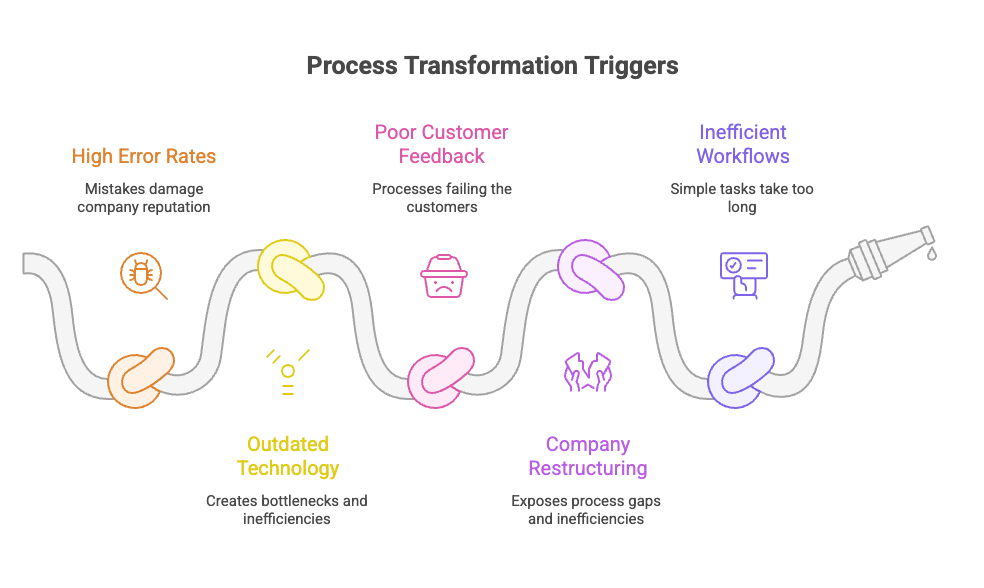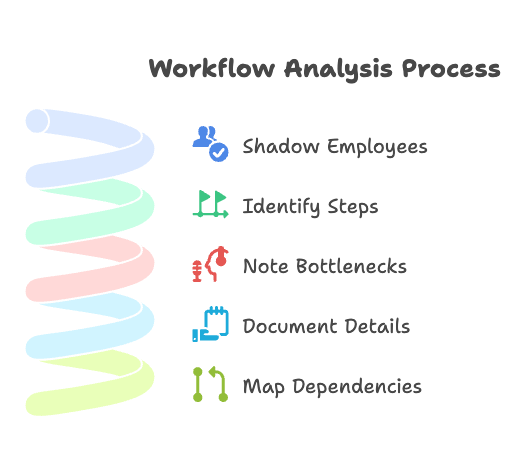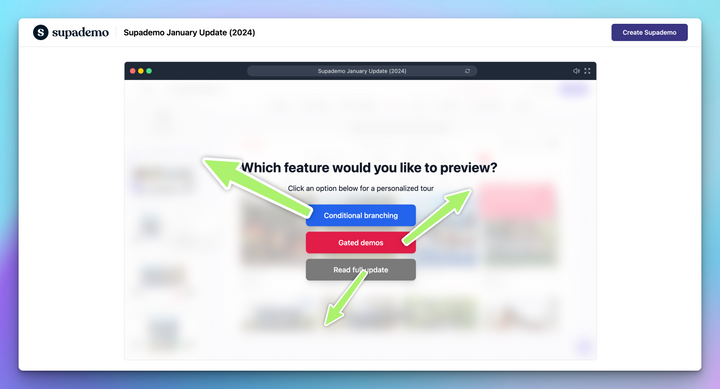Your sales team loses deals because quotes take two weeks to approve. Customer service spends more time transferring calls than solving problems. New employees quit within months because basic tasks require navigating five different systems that don't talk to each other.
Every day these broken processes run, you're hemorrhaging money and reputation. Customers choose faster competitors, top talent goes elsewhere, and your team burns out trying to deliver results with outdated tools. While you're manually processing invoices, competitors are automating everything and stealing market share.
This guide shows you how to systematically rebuild your workflows using proven methods that deliver results. You'll see real examples of companies that transformed their operations and get practical steps to implement immediately.
• Business process transformation means completely redesigning workflows instead of fixing broken ones.
• Companies do this to cut costs, improve customer experience, boost productivity, and stay competitive.
• Most transformations fail due to poor stakeholder alignment, change resistance, inadequate documentation, and lack of ongoing reinforcement.
• Success requires six steps: audit current processes, set clear goals, involve stakeholders early, redesign and document workflows, roll out in phases, and continuously measure and iterate.
• Real-world companies like ReelDx, ProcessMaker, and Musixmatch have used this approach to save time, reduce costs, and improve results.
What is business process transformation?
Business process transformation is the complete redesign of how your company operates. Instead of fixing existing (broken) workflows, you throw them out and build entirely new processes using modern technology and automation.
It's about reimagining work from scratch to make operations faster, cheaper, and more efficient while improving customer and employee experiences.
Business process transformation vs process improvement
| Aspect | Process Improvement | Business Process Transformation |
|---|---|---|
| Approach | Fix existing processes | Completely redesign processes |
| Scope | Small, incremental changes | Large-scale, fundamental changes |
| Timeline | Weeks to months | Months to years |
| Investment | Low to moderate cost | High upfront investment |
| Risk | Low risk, predictable outcomes | Higher risk, bigger potential rewards |
| Technology | Uses existing systems | Often requires new technology |
| Impact | 10–30% improvement | 50–300% improvement potential |
| Disruption | Minimal business disruption | Significant operational changes |
| Example | Reduce approval steps from 5 to 3 | Automate entire approval process |
| Best For | Stable processes needing tweaks | Broken, outdated, or inefficient processes |
| Measurement | Gradual performance gains | Dramatic performance shifts |
| Employee Impact | Minor training needed | Extensive retraining required |
Why is business process transformation important?
Companies that don't transform their processes get left behind. In today's fast-moving business world, outdated workflows cost money, frustrate customers, and drain employee productivity.
Here's why process transformation isn't optional anymore:
1. Reduce costs
Process transformation cuts expenses by eliminating manual work and reducing errors. Automating routine tasks lowers labor costs while improving accuracy.
Companies save money by using resources more efficiently and avoiding expensive mistakes. The cost savings often pay for the transformation project within the first year.
2. Improve customer experience
Today's customers expect fast, accurate service, and outdated processes simply can't deliver. Process transformation eliminates the frustrating experiences we've all had - long wait times, being transferred between departments, or having to repeat information multiple times.
When processes are streamlined, customers get quicker responses and more personalized service, leading to higher satisfaction and stronger loyalty.
3. Increase employee productivity
Nobody enjoys fighting inefficient systems or spending hours on tasks that should take minutes. Process transformation removes these daily frustrations by automating repetitive work and creating clearer workflows.
This allows employees to focus on meaningful, strategic activities instead of administrative busywork. The result is higher job satisfaction, better retention, and more productive teams.
4. Stay competitive
Markets move quickly, and companies with rigid, slow processes struggle to keep up. Process transformation creates the agility needed to respond to market changes, customer demands, and new opportunities.
While competitors are stuck with outdated systems that slow them down, transformed companies can adapt quickly, launch products faster, and capture market share.
What triggers the need for process transformation?

Most companies don't wake up one day and decide to transform their processes.
Usually, there are clear warning signs that existing workflows are holding the business back.
Here are the most common triggers that signal it's time to make significant changes:
1. High error rates
When mistakes become a regular part of your operations, it's a red flag that your processes are broken.
Whether it's billing errors, data entry mistakes, or quality control issues, high error rates cost money and damage your reputation. If your team spends more time fixing problems than preventing them, your current processes aren't working.
2. Outdated technology
Using systems that were built years or decades ago creates bottlenecks and inefficiencies throughout your organization. When your technology can't integrate with modern tools or requires constant manual workarounds, it's time for transformation.
3. Poor customer feedback
Customer complaints about slow service, poor communication, or complicated processes are direct signals that your workflows need an overhaul.
When customers consistently report frustrating experiences, your processes are failing the people who matter most.
4. Company restructuring
Mergers, acquisitions, rapid growth, or organizational changes often expose process gaps and inefficiencies.
Processes that worked for a smaller company may collapse under increased volume or new business structures.
5. Inefficient workflows
When simple tasks take too long, require too many approvals, or involve too many people, your workflows have become inefficient.
Signs include employees waiting for approvals or tasks that should take hours stretching into days.
Why do business transformation processes fail?
Most failures aren't due to bad ideas or poor technology choices; they happen because organizations underestimate the human and organizational challenges involved.
Here are the most common reasons why transformation efforts derail:
1. Difficulty in aligning stakeholders
When different departments can't agree on what they're trying to achieve, transformation projects fall apart quickly. Common alignment problems include:
- Conflicting priorities - Marketing wants faster lead processing while Finance demands more approval steps
- No clear ownership - Everyone assumes someone else is responsible for making decisions
- Strategy gets lost in translation - The boardroom vision becomes confusing by the time it reaches workers
Without a unified vision that everyone understands and supports, even the best transformation plan will fail.
2. Resistance to change management
People naturally resist changes to their daily routines, especially when they don't understand why changes are happening.
Resistance shows up as:
- Fear of job loss due to automation - Employees worry automation will replace them
- Comfort with current systems - "We've always done it this way" feels safer than uncertain new methods
- Lack of involvement - People resist changes they had no voice in creating
- Poor communication - Leaders fail to explain the benefits of new processes
When employees aren't brought into the process early, they become obstacles instead of champions.
3. Poor process documentation
Many organizations jump into transformation without understanding their current processes or defining what success looks like. Process documentation problems include:
- No clear current state - Teams don't know how work actually gets done today
- Vague future vision - Goals like "be more efficient" aren't specific enough
- Missing work instructions - Employees don't know how to use new systems
- Unclear roles - People don't understand their responsibilities in new processes
- No success metrics - Organizations can't tell if changes are working
Without proper documentation of both current and future states, teams work from assumptions that often prove wrong, leading to confusion and failed implementation.
4. Lack of reinforcement
Transformation isn't a one-time project – it requires ongoing attention and adjustment. Many initiatives fail because organizations:
- Treat it as a project - Once launched, leaders move on to other priorities
- Don't monitor results - No one tracks whether new processes are actually working
- Skip continuous improvement - Problems aren't fixed as they arise
- Don't celebrate wins - Teams lose motivation without recognition of progress
Without continuous reinforcement of new behaviors, people slowly drift back to familiar ways of working.
6 steps to implement a successful business process transformation
Business process transformation isn't just about upgrading software—it's about reimagining how work flows through your organization to eliminate waste, reduce friction, and create measurable value for both employees and customers.
Step 1: Audit and map current workflows
Before you can improve anything, you need to understand what you're actually working with. This means documenting how work really gets done, not how you think it gets done.

What to do:
- Shadow employees as they complete tasks to see the real process
- Identify every step, handoff, and decision point in your current workflows
- Note where bottlenecks, delays, and errors occur most frequently
- Document who's involved, what tools they use, and how long each step takes
- Map dependencies between different processes and departments
Why this matters: Most organizations discover their actual processes are much messier than they imagined. You can't fix problems you don't know exist.
Step 2: Set transformation goals and KPIs
Vague goals like "improve efficiency" doom projects from the start. You need specific, measurable targets that everyone can understand and track.
Focus on these four key metrics that matter most for transformation success:
- Adoption rates - What percentage of people are actually using new processes
- Time-to-competency - How long it takes employees to master new workflows
- Support volume - Number of help requests and questions about new processes
- Stakeholder alignment - How well different teams agree on goals and priorities
Step 3: Involve stakeholders early
Get your stakeholders involved in designing solutions, not just implementing them.
How to engage stakeholders:
- Include frontline workers who actually do the work in planning sessions
- Use interactive demos to show how workflows will change to get stakeholder and cross-functional approvals.
Instead of describing new processes in meetings, create interactive demos that show exactly how workflows will work. When people can see and click through new processes, they understand what's coming and feel more prepared for change.
Here's what an interactive demo looks like:
Step 4: Redesign and document your processes
Good documentation prevents confusion and ensures consistency. People need clear guidance on what to do and how to do it.
For process design:
- Use flowcharts to map out new workflows step-by-step
- Create checklists for complex procedures to prevent missed steps
- Build process diagrams that show decision points and alternative paths
For documentation:
- Use Notion to create detailed process guides with step-by-step instructions
- Include Supademo visual workflows in your documentation for better knowledge retention

- Make sure documentation is easily accessible and searchable
- Update guides immediately when processes change
People retain information better when they can see processes in action, not just read about them in text.
Step 5: Rollout in phases
How you implement changes determines whether people adopt them successfully. Choose the rollout strategy that matches your organization's risk tolerance and capacity for change.
Here are 3 approaches for implementing process changes:
| Approach | Timeline | Risk Level | Best For | How It Works |
|---|---|---|---|---|
| Phased Implementation | 3–6 months | Low | Large organizations with multiple departments or locations | Roll out to one department/location at a time. Start with most enthusiastic teams, then expand based on lessons learned. |
| Pilot Program | 4–8 week pilot + 2–4 months rollout | Medium | New or complex processes with uncertain outcomes | Test with 10–20 users. Gather feedback, refine, then expand to wider teams. |
| Cold Turkey | 2–4 weeks intensive prep | High | Simple process changes with top-down buy-in | All users switch to the new process on the same day, backed by heavy pre-launch support. |
Step 6: Measure adoption and iterate

Transformation doesn't end when you launch new processes. The real work begins with ensuring people actually use them and making adjustments based on real-world results.
Track these metrics using Supademo analytics:
- Completion rates - How many people finish new processes successfully
- Repeat usage - Whether people continue using new workflows over time
- Drop-off points - Where people abandon new processes and revert to old ways
- Time spent - How long new processes actually take compared to predictions
Create feedback loops:
- Regular check-ins with process users to identify pain points
- Quick surveys to gauge satisfaction and identify improvement opportunities
- Open channels for reporting problems and suggesting changes
- Monthly reviews of metrics to spot trends and issues early
Real-world examples of business process transformation
If you're wondering what a successful business process transformation looks like, we've covered real-world examples for you to take inspiration from.
Customer onboarding
ReelDx, a healthcare education platform, was spending hours on live walkthroughs for every new customer, creating weeks-long delays that caused prospects to drop off.
They transformed their process by creating interactive, self-guided product tours using Supademo, allowing customers to explore the platform immediately through role-specific walkthroughs.
“For a really long time, we’ve been looking for an easy onboarding solution that meaningfully allows users to try the platform. We explored a lot of solutions, but none were as easy as Supademo." - Rob Humbracht CEO
This eliminated waiting times, onboarded 100+ customers through self-service, and saved 12+ hours per month on manual calls. The key insight: customers preferred exploring at their own pace rather than sitting through generic demos.
Sales outreach
ProcessMaker, a workflow automation enterprise, was building custom demos for every prospect, spending 8-10 hours per week per rep on preparation for often unqualified leads.
“Supademo has completely transformed our early-stage demo motion. Gone are the days of custom demos for unqualified prospects."
- Casey O'Brien, Solutions Consulting Director
They transformed their approach by using Supademo to create automated early-stage proof-of-concepts, allowing prospects to explore features instantly instead of waiting for scheduled calls.
• Eliminated custom demos for unqualified leads through automated POCs
• Saved 8-10 hours weekly per sales rep.
• Double-digit increase in deals closed as buyers self-educated before sales calls
• Reduced sales cycle friction by letting prospects explore features instantly
AI workflow automation
Musixmatch, a lyrics provider serving 80 million users and platforms like Spotify and Apple Music, was wasting engineering resources on manual data requests. Their technical staff spent time fetching and analyzing client data instead of working on product development.
Senior Product Manager Martino Bonfiglioli implemented n8n as an automation interface that enabled non-technical stakeholders to access internal APIs through custom modules, eliminating the need for engineering involvement in routine data requests.
• Saved 47 days of manual engineering work
• Reduced client response times via automated data processing
• Built 27 custom workflow modules including complex data transformations
• Enabled non-technical users to handle their own data requests
• Cut processing time from manual work to 15 seconds for complex workflows
Simplifying feature adoption
Porter Metrics, a cross-channel marketing reporting platform, struggled with the technical complexity of existing product tour platforms that were limited to in-app use cases, clunky to set up, and difficult to scale. Their marketing team spent significant time manually creating product tours and updating them whenever features changed.
They transformed their approach by using Supademo to create interactive, self-paced demos that showed product value without requiring sign-ups, building over 100 demos across their landing pages, help docs, and feature pages.
• Built 100+ interactive demos across multiple touchpoints
• Saved hours on content creation and updates
• Reduced customer support calls through self-service demos
• Accelerated time-to-value for prospects exploring features
• Improved user engagement leading to higher conversions
How Supademo accelerates your process transformation
Throughout this guide, you've seen how companies like ReelDx, ProcessMaker, and Porter Metrics used interactive demos to transform their processes. Supademo isn't just a demo tool - it's a process transformation accelerator that addresses the core challenges we've discussed.
- Solve stakeholder alignment issues: Instead of describing new processes in meetings, create interactive walkthroughs that show exactly how workflows will work. When stakeholders can see and click through proposed changes, they understand what's coming and provide better feedback.
- Reduce change resistance: People resist changes they don't understand. Interactive guides let employees explore new processes safely before implementation, building confidence and reducing fear of the unknown.
- Improve documentation quality: Replace static process documents with visual, step-by-step walkthroughs that people actually follow. Supademo's no-code editor lets you update processes instantly when changes occur, keeping documentation current.
- Enable phased rollouts: Create role-specific demos for different user groups, departments, or locations. Track usage analytics to see who's engaging with new processes and where people get stuck.
- Measure and iterate effectively: Built-in analytics show completion rates, drop-off points, and time spent on each step. Use this data to identify problems early and make adjustments before full rollout.
Try Supademo today to accelerate digital transformation and adoption
FAQs
How long does business process transformation take?
Simple processes take 2-4 months, complex transformations need 6-12 months. Phased rollouts extend timelines but reduce risk. Success depends more on stakeholder alignment than timeline length.
How do you overcome employee resistance to change?
Involve employees in designing solutions, not just implementing them. Use visual demos to show exactly how processes will work. Address concerns early and celebrate quick wins.
Which processes should we transform first?
Start with processes that directly impact customers or waste significant employee time. Customer onboarding, sales workflows, and repetitive administrative tasks deliver the fastest, most visible results.
What is an example of a business process transformation?
Let's say a company is using manual methods where employees receive paper invoices, manually enter data into spreadsheets, and send them through multiple departments for approval. This transformation would completely redesign the workflow using automated invoice scanning, digital approval workflows, and direct integration with accounting systems.




